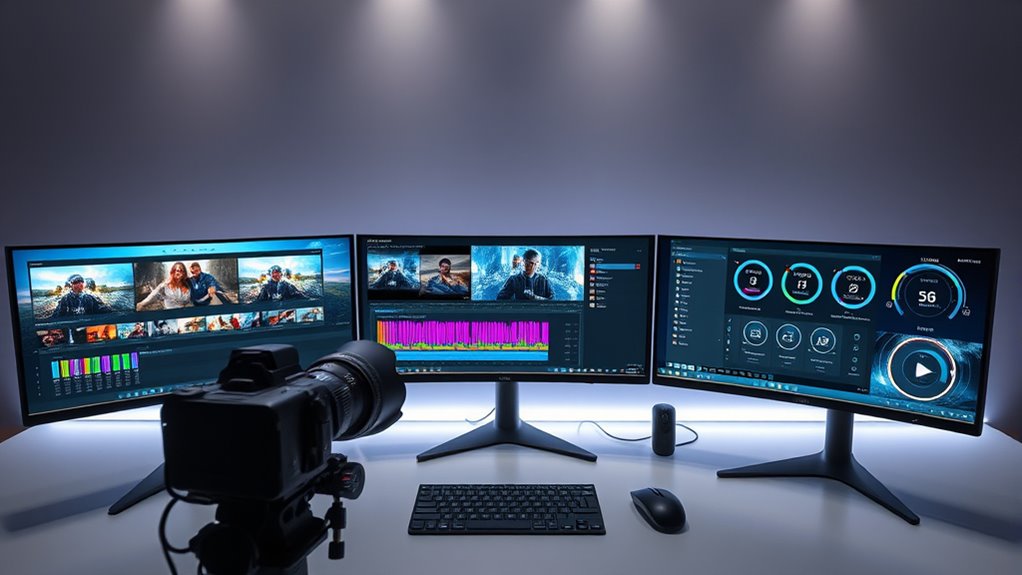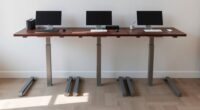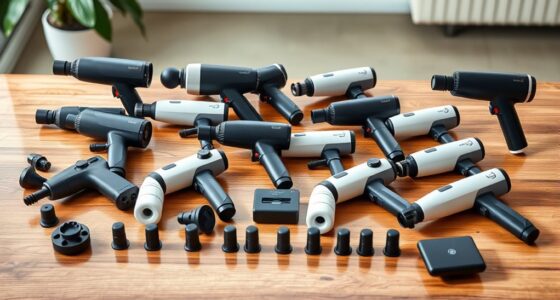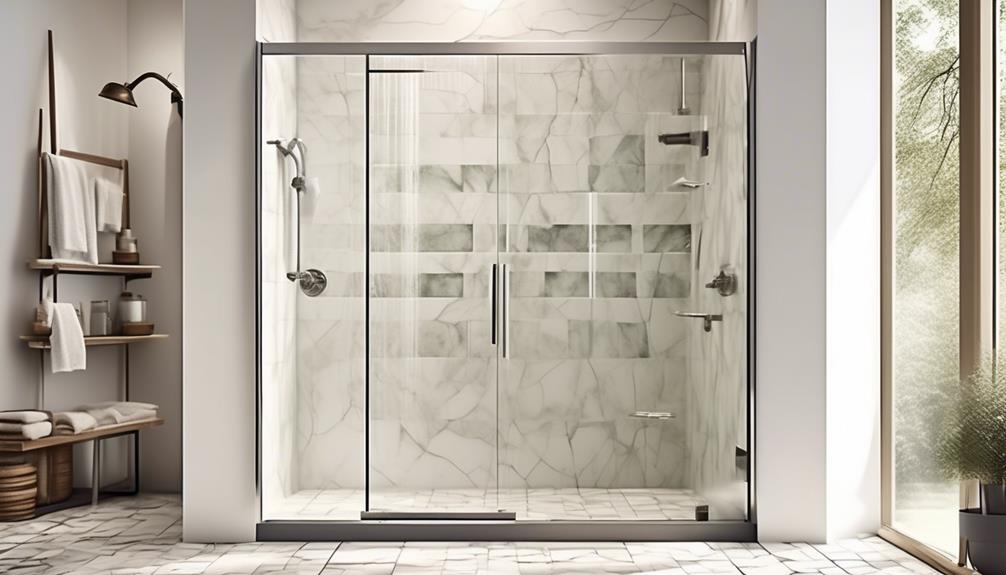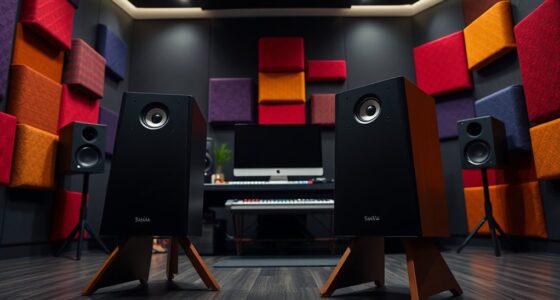If you’re looking to improve your workflow in 2025, I recommend checking out the top ultrawide monitors designed for video editing and multitasking. These models offer high resolutions like 3440×1440 or 3840×1600, great color accuracy, and wide gamuts for precise editing. They feature curved screens for comfort and ample connectivity options. If you keep exploring, you’ll find even more details to help you pick the perfect monitor for your needs.
Key Takeaways
- Prioritize high-resolution screens (1440p, 4K) with HDR support for sharp, color-accurate visuals essential in video editing.
- Choose monitors with wide color gamuts (95% DCI-P3 or 120% sRGB) and high color fidelity (ΔE < 2) for precise color grading.
- Opt for large (34″+), curved ultrawide displays with aspect ratios like 21:9 or 32:9 to maximize workspace and immersion.
- Ensure multiple connectivity options (USB-C, HDMI, DisplayPort) and ergonomic adjustments for seamless workflow and comfort.
- Consider refresh rates of 120Hz+ and low response times for smooth previewing, with good warranty coverage for long-term reliability.
CRUA 30-Inch Ultrawide Curved Monitor (2560x1080P, 1500R, 120Hz, FreeSync)
If you’re looking for an ultrawide monitor that enhances your video editing workflow, the CRUA 30-Inch Ultrawide Curved Monitor is a great choice. Its 29.5-inch VA panel with a 2560×1080 resolution and 1500R curvature delivers immersive visuals with vibrant colors thanks to a 120% sRGB gamut. The wide 178° viewing angle guarantees consistent clarity from multiple perspectives. With a 120Hz refresh rate and FreeSync support, it offers smooth playback and reduced tearing, ideal for multimedia. Adjustable tilt and versatile connectivity options make it user-friendly, while its curved design boosts immersion, making it perfect for detailed editing and multitasking.
Best For: users seeking an immersive ultrawide curved display ideal for video editing, multitasking, and multimedia consumption with vibrant visuals and smooth performance.
Pros:
- Vibrant 120% sRGB color gamut enhances color accuracy and visual richness
- 1500R curvature provides immersive viewing experience and reduces eye fatigue
- Versatile connectivity options and ergonomic tilt adjustment for user convenience
Cons:
- Limited height adjustment may affect ergonomic comfort for some users
- Some quality control issues reported, such as burn-in discoloration or connectivity glitches
- Capable of supporting up to 120Hz via DisplayPort, but HDMI may be limited to 144Hz, affecting certain setups
INNOCN 40C1R Ultrawide Monitor 40 WQHD Display
The INNOCN 40C1R ultrawide monitor stands out as an excellent choice for video editors who need expansive screen real estate combined with stunning color accuracy. Its 40-inch WQHD display with a 21:9 aspect ratio delivers 3440 x 1440p resolution, perfect for multitasking and detailed editing. The premium ADS IPS panel covers 95% DCI-P3, ensuring vibrant, accurate colors, while HDR400 and HDR500 support enhance dynamic range. With a 144Hz refresh rate via DisplayPort and solid connectivity options—including USB-C, HDMI, and DisplayPort—it offers smooth performance. Adjustable stand, high brightness, and low blue light technology make long editing sessions comfortable and productive.
Best For: video editors and creative professionals seeking expansive, color-accurate ultrawide screens for multitasking and detailed editing work.
Pros:
- 40-inch ultrawide display with high resolution and 95% DCI-P3 color gamut for vibrant, accurate colors
- Adjustable stand with tilt, swivel, and height options enhances ergonomic comfort during long editing sessions
- Multiple connectivity options including USB-C, HDMI, and DisplayPort support versatile device connections
Cons:
- Packaging issues such as fragile packaging and loose base may affect setup and transport
- HDR performance can be inconsistent; activation and calibration are necessary for optimal display quality
- Limited firmware support and potential compatibility issues with custom resolutions or advanced settings
Dell 34 Plus USB-C Curved Monitor (S3425DW)
The Dell 34 Plus USB-C Curved Monitor (S3425DW) stands out as an ideal choice for video editors who need a wide, immersive workspace combined with excellent color accuracy. Its 34-inch curved VA panel delivers 3440×1440 resolution with vibrant, true-to-life colors—covering 99% sRGB and 95% DCI-P3—and HDR support for enhanced detail. The 120Hz refresh rate ensures smooth visuals, while features like anti-glare coating and wide viewing angles improve clarity. Connectivity is streamlined with a USB-C port that supplies 65W power, along with HDMI and DisplayPort options. Ergonomics, decent built-in speakers, and a sleek design make this monitor a versatile, cost-effective choice for video editing and multitasking.
Best For: video editors and creative professionals seeking a wide, color-accurate display with smooth visuals for multitasking and detailed editing.
Pros:
- Excellent color coverage with 99% sRGB and 95% DCI-P3 for true-to-life colors
- Wide 3440×1440 resolution and 120Hz refresh rate enhance detail and smoothness
- Versatile connectivity options including USB-C with 65W power delivery and HDR support
Cons:
- Stand stability issues noted by some users, potentially requiring additional mounting solutions
- Slight vignetting or grain from matte coating may affect image uniformity for some users
- Response time may produce minimal ghosting in fast-paced gaming, limiting its use for competitive gaming
34 Inch Ultrawide Curved Gaming Monitor with FreeSync
A 34-inch ultrawide curved gaming monitor with FreeSync is an excellent choice for video editors who need ample screen space and smooth performance. Its 1500R curvature boosts immersion, while the 21:9 aspect ratio and 3440 x 1440 UWQHD resolution provide 30% more workspace than standard monitors. With a brightness of 300 cd/m², HDR support, and 8-bit color depth covering 120% sRGB, visuals stay vivid and detailed. The 165Hz refresh rate and AMD FreeSync minimize tearing, delivering seamless playback. Multiple ports, including HDMI and DisplayPort, ensure easy connectivity, making this monitor versatile for both work and entertainment.
Best For: video editors and creative professionals who need expansive screen space, vivid visuals, and smooth performance for multitasking and editing tasks.
Pros:
- Large 34-inch ultrawide curved display enhances immersion and provides ample workspace for multitasking.
- High resolution of 3440 x 1440 UWQHD with HDR support ensures vivid, detailed visuals.
- Fast 165Hz refresh rate with FreeSync minimizes tearing and delivers seamless playback for video editing and gaming.
Cons:
- The wide aspect ratio may require adjustments to existing workspace setups or software configurations.
- Curved design might not be suitable for users preferring flat monitors for precise editing tasks.
- Limited to specific ports (HDMI 2.0 and DisplayPort 1.4), which may require adapters for some devices.
SAMSUNG ViewFinity S50GC Ultrawide QHD Monitor
If you’re a video editor looking for a monitor that offers expansive screen real estate, the Samsung ViewFinity S50GC Ultrawide QHD stands out as an excellent choice. Its 34-inch Ultra-WQHD display with a 3440×1440 resolution and 21:9 aspect ratio provides ample space for multitasking and detailed editing. The vibrant visuals are supported by HDR10, over a billion colors, and a 100Hz refresh rate, ensuring smooth motion and color accuracy. Features like PIP and PBP modes boost productivity, while eye care tech reduces fatigue during long sessions. Overall, it’s a versatile, visually stunning monitor tailored for professional workflows and immersive multimedia experiences.
Best For: professionals such as video editors, multitaskers, and creative users seeking expansive, high-quality ultrawide workspace.
Pros:
- Large 34-inch Ultra-WQHD display with vibrant colors and HDR10 support for vivid visuals
- Features like PIP and PBP modes enhance multitasking and productivity
- Eye Care technology reduces fatigue during extended use, promoting comfort
Cons:
- Limited stand adjustability may affect ergonomic positioning
- Reflection issues could impact visibility in bright environments
- No built-in speakers, requiring separate audio solutions
Factors to Consider When Choosing Ultrawide Monitors for Video Editing and Multitasking

When selecting an ultrawide monitor for video editing and multitasking, I focus on key factors like resolution, color accuracy, and screen size. It’s also important to take into account the curvature, connectivity options, and ergonomic adjustments to guarantee comfort during long editing sessions. These elements help me find a monitor that boosts productivity and delivers precise visuals.
Screen Resolution Quality
Choosing the right screen resolution is vital for effective video editing and multitasking on ultrawide monitors. Higher resolutions, like 3440×1440 or 2560×1080, provide sharper images and more detail, which is essential for precise editing. While a minimum of 1080p (Full HD) is acceptable, resolutions like 1440p or 4K are ideal for professional work, offering greater clarity and workspace. These higher resolutions allow more timeline tracks, panels, and windows to be open simultaneously, boosting productivity. Additionally, many high-resolution ultrawide monitors support HDR, enhancing contrast and color depth—beneficial for editing workflows. Ultimately, choosing a monitor with a suitable resolution guarantees your visuals are sharp, detailed, and accurate, streamlining your editing process and multitasking efficiency.
Color Accuracy & Gamut
A key factor in selecting an ultrawide monitor for video editing is its color accuracy and gamut, which directly impact how true-to-life your visuals appear. A wider color gamut, like 95% DCI-P3 or 120% sRGB, ensures vibrant, precise colors essential for professional work. To achieve true color accuracy, look for monitors calibrated to a ΔE less than 2, minimizing discrepancies. Support for HDR10 or higher standards enhances contrast and depth, making detailed edits more accurate. IPS or ADS panels typically provide better color consistency and wider viewing angles than VA or TN panels, which is fundamental for multitasking and collaborative reviews. Additionally, high bit-depth support (8-bit or higher) ensures smooth gradients and reduces banding, indispensable for nuanced color grading.
Screen Size & Curvature
Selecting the right screen size and curvature is essential for optimizing your video editing workflow and multitasking efficiency. Larger screens, like 34 inches or more, offer ample workspace for detailed editing and viewing multiple windows simultaneously. Curved monitors with a radius of 1500R or similar enhance immersion by wrapping the display around your field of view, reducing edge distortion and providing more consistent image quality. Ultrawide aspect ratios such as 21:9 or 32:9 expand horizontal real estate, allowing you to view timelines and multiple applications side by side. The curvature also influences how light and color are perceived, improving visual consistency during editing. Balancing screen size, curvature, desk space, and comfort ensures your setup aligns with your workflow needs and workspace constraints.
Connectivity Options
To optimize your video editing setup, it’s crucial to prioritize the monitor’s connectivity options, as they determine how seamlessly you can integrate multiple devices and peripherals. Look for a monitor with a variety of ports like HDMI, DisplayPort, and USB-C, which support connecting multiple devices simultaneously. USB-C is especially valuable because it can handle power, video, and data transfer through a single cable, simplifying your workspace. Confirm the monitor supports HDMI 2.0 or DisplayPort 1.4 for high resolutions and fast refresh rates essential for smooth editing and multitasking. Additional features like audio outputs and built-in USB hubs can streamline your workflow by connecting peripherals directly to the monitor. Finally, check for VESA compatibility and flexible port arrangements to optimize positioning and ergonomic setup.
Adjustable Ergonomics
Since prolonged video editing and multitasking can cause discomfort, it’s crucial to choose an ultrawide monitor with adjustable ergonomic features. Look for monitors that offer tilt, swivel, height adjustments, and VESA compatibility, so you can customize the setup to fit your workspace and preferences. Adjustable stands help optimize viewing angles, supporting better posture and reducing neck and eye strain during long sessions. A wide range of ergonomic options ensures your monitor can adapt to different setups, increasing comfort and productivity. Monitors without these features can lead to discomfort or repetitive strain injuries over time. Prioritizing comprehensive ergonomic adjustments enables you to maintain proper alignment, work more efficiently, and enjoy a more comfortable editing and multitasking experience.
Refresh Rate & Response
A high refresh rate and low response time are vital for smooth, accurate video editing and multitasking on an ultrawide monitor. A refresh rate of 120Hz or higher ensures fluid motion, which is especially helpful when previewing videos or working with fast-paced content. Low response times, around 1-3ms, reduce ghosting and motion blur, making fast-moving visuals clearer and more precise. Together, these specs improve real-time editing accuracy and minimize lag during interactive tasks. Consistent refresh rates help prevent flickering and maintain frame stability across different media formats, indispensable for professional video work. Overall, a monitor with a high refresh rate and low response time enhances visual fluidity, making detailed editing and multitasking smoother and more reliable.
Price & Warranty
When choosing an ultrawide monitor for video editing, evaluating the price and warranty options is essential to guarantee you’re getting good value and long-term support. I recommend looking for models with warranties that cover pixel defects, color accuracy issues, and panel failure, especially since these are critical for maintaining display quality. Longer warranties often mean better build quality and more peace of mind, particularly in professional environments. While higher-priced models tend to offer these benefits, it’s important to compare features to ensure you’re not overpaying. Also, choose manufacturers known for reliable customer support and clear return policies, so you can address any issues promptly. Balancing cost with warranty coverage helps protect your investment and assures consistent performance for your creative work.
Frequently Asked Questions
What Is the Ideal Resolution for Professional Video Editing on Ultrawide Monitors?
The ideal resolution for professional video editing on ultrawide monitors is 3440×1440 pixels. This offers a great balance between sharp image quality and manageable file sizes, giving me plenty of screen real estate for timelines and previews. If I want even more detail, I opt for 3840×1600, which enhances clarity without sacrificing performance. Ultimately, I look for resolutions that support accurate color grading and smooth workflow.
How Does Monitor Curvature Affect Multitasking and Editing Accuracy?
Monitor curvature greatly enhances multitasking and editing accuracy by creating a more immersive viewing experience. It minimizes distortions and glare, allowing me to see the entire screen comfortably without frequent head movements. This helps me focus better and work more efficiently across multiple windows. Plus, the curved design aligns with my natural eye movement, making detailed editing smoother and reducing eye strain during long sessions.
Are There Specific Color Calibration Features Important for Video Editing?
Yes, color calibration features are essential for video editing. I look for monitors with hardware calibration support, wide color gamuts like DCI-P3 or Adobe RGB, and factory calibration reports. These guarantee color accuracy and consistency across projects. Adjustable color profiles and calibration tools built into the monitor also help me fine-tune the display, so I can trust my colors are true to life—vital for professional quality work.
What Connectivity Options Are Essential for Seamless Workflow Integration?
You need HDMI, DisplayPort, and USB-C for seamless workflow integration. HDMI guarantees compatibility with most devices, DisplayPort offers high refresh rates ideal for editing, and USB-C provides versatile, power delivery, and data transfer. I always look for monitors that include these options because they keep my setup flexible and clutter-free. Having multiple connectivity choices lets me switch between devices effortlessly and keeps my workflow smooth and efficient.
How Does Refresh Rate Impact Video Editing and Real-Time Editing Performance?
A higher refresh rate considerably improves video editing and real-time performance by providing smoother playback and reducing motion blur. When I use a monitor with at least 120Hz, I notice less lag and more responsive editing, especially during fast-paced footage. It makes previewing edits more accurate and seamless, allowing me to work more efficiently. So, for better editing experience, prioritize monitors with higher refresh rates for smoother, more precise visuals.
Conclusion
Choosing the right ultrawide monitor can truly transform your workflow, making editing smoother and multitasking effortless. I’ve found that when I finally settled on one that fit my needs, it felt like everything clicked into place—like discovering a missing piece. Whether you’re editing videos or juggling multiple apps, the right screen can make all the difference. So, trust your instincts, and soon you might find yourself wondering how you ever worked without that perfect ultrawide setup.

